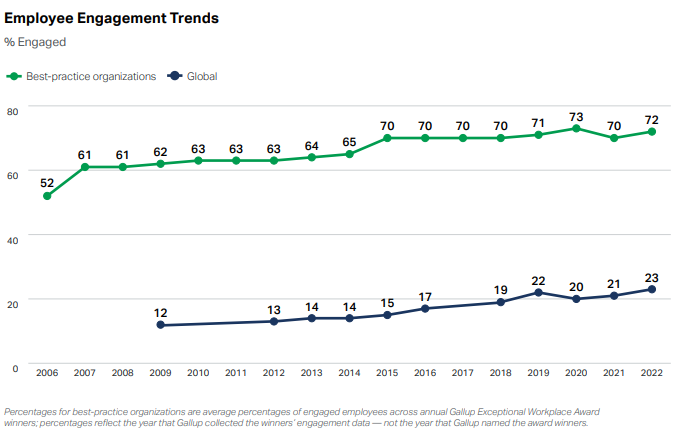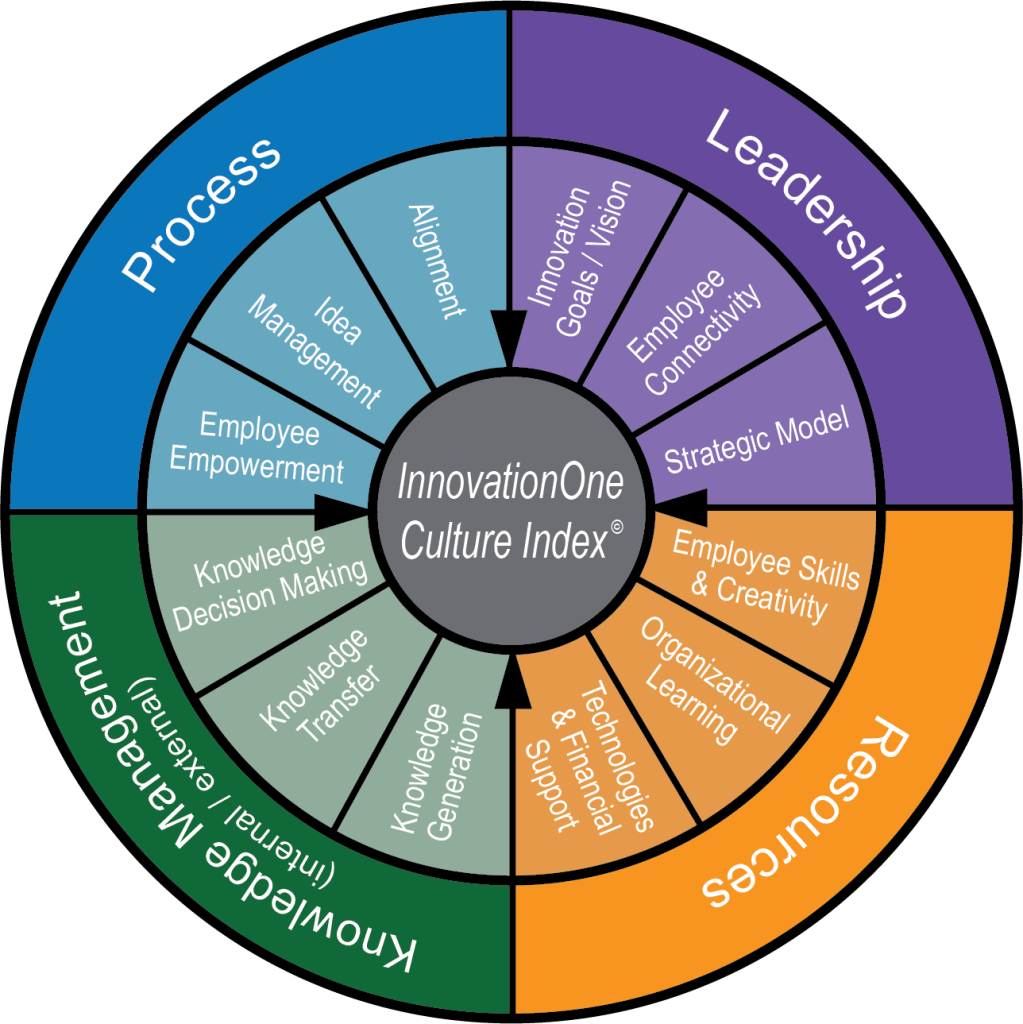By Victor Assad, Managing Partner of InnovationOne, LLC
Gallup’s 2023 State of the Global Workforce reveals a wealth of information about the workplace and the workforce. For example, did you know that:
- Employee engagement and job opportunities in the US and Canada stand at 31 percent, down from 33 percent in 2021—the surge year for these countries. Looking globally, the figure is 23 percent.
- Employee stress is at an all-time high at 52 percent in the US and Canada (two percent higher than in 2021) and 44 percent globally. Stressed-out employees are open to looking for other job opportunities in the growing Western and East Asian economies.
- The public debate over returning employees to the office to improve productivity misses the point. The office alone has no magic to create a great organizational culture or improve the skills of managers.
Gallup’s report, published last week, shows that the majority of the world’s employees are “quiet quitters.” If management wants to improve the number of their engaged employees at work, Gallup suggests they should focus on fixing their cultures and improving the skills of managers.
Gallup’s definitions of engaged and non-engaged employees
According to Gallup, engaged employees are thriving at work. These people find their work meaningful and feel connected to the team and organization. They feel proud of the work they do and take ownership of their performance, going the “extra mile” for teammates and customers.
Non-engaged employees, or what Gallup now calls “quiet quitters,” put in the minimum effort required and are psychologically disconnected from their employer. They are more likely to be stressed and burnt out than engaged workers because they feel lost and disconnected from their workplace. The level of non-engaged employees is up slightly from previous years.
Gallup suggests that non-engaged workers are an organization’s greatest opportunity for growth and change. They are waiting for a leader to have a conversation with them, encourage and inspire them.
Actively disengaged employees, or what Gallup now calls “Loud Quitters,” are employees who take actions that directly harm the organization, undercutting its goals and opposing its leaders. Gallup reports that 18 percent of the world’s employees are behaving in this fashion.
Improving engagement raises organizational performance
Looking at the big picture, Gallup reports that quiet quitters represent an immense opportunity for economic growth. Gallup estimates that low engagement costs the global economy US$8.8 trillion and accounts for 9% of global GDP. Leadership and management directly influence workplace engagement, and there is much that organizations can do to help their employees thrive at work and raise performance.
In the chart below from Gallup’s State of the Global Workplace: 2023 Report, Gallup contrasts the percentage of engaged employees globally with the percentage of engaged employees in their “best-practice organizations.” The engagement level for the Best-practice organizations is much higher. The difference is startling. Among the Best-practice organizations the higher engagement level in 2022 is 72 percent, while it is 23 percent for the other global companies. In other reports, Gallup has reported that the Best-practice organizations have focused on improving their cultures and the skill level of their managers.
Gallup’s data shows that the manager is the linchpin of engagement. Seventy percent of team engagement is attributable to the manager. But many or most managers are quiet-quitting too. They are waiting for the tools to build great teams. The good news is that cutting-edge, science-based management can be taught. This is why focusing on increasing the number of engaged employees begins with improving the engagement and skills of managers.
Worker Stress at All-Time High
Gallup reports that although the world has recovered from the worst of the pandemic, employee stress remains at a record-high level. Forty-four percent of global employees surveyed by Gallup said they experienced a lot of stress the previous day, repeating the record high in 2021 and continuing a trend of elevated stress that began almost a decade earlier. East Asia, which includes China, tied the U.S. and Canada regions for the highest levels of stress at 52 percent.
According to Gallup, engagement has 3.8 times as much influence on employee stress as work location. In other words, what people experience in their everyday work — their feelings of involvement and enthusiasm — matters more in reducing stress than where they are sitting. Leaders need to ask if poor remote work performance or poor hybrid work performance is a location problem or a management problem.
No location can fix poor management, and the office alone has no magic to create a great organizational culture.
Employee Suggestions for Making Improvements
Quiet quitting employees identified for Gallup what they would change about their workplace to make it better.
Eighty-five percent of the responses offered by those considered to be quieting quitting were related to engagement or culture, pay and benefits, or wellbeing-work/life balance. Please note that fixing engagement or organizational culture leads the list significantly over improvements to pay and benefits and wellbeing. Please see Gallup’s chart from the 2023 Workforce Report, below.
Unhappy employees are likely to look for better jobs in this abundant job market.
In 2022, the world experienced a widespread resurgence in jobs. In the US, unemployment is roughly half of job postings. Gallup’s survey reveals that 53 percent of employees in 2022 said now is a good time to find a job where they live, a sharp increase from the previous year and close to the record high in 2019. The increase in available jobs is a positive change for workers. It means that deeply unhappy workers can leave bad workplaces, and more workers are able to find work that they like.
What should executives do?
Don’t take the current situation sitting down. Instead, pursue these objectives:
Raise Management Skills. Improving the skills of management is a great place to start to reduce turnover and to convert the number of non-engaged employees into engaged (and more productive and innovative) ones.
Improve culture. The categories suggested by employees taking Gallup’s survey, above, are a good starting place for thinking about how to improve culture and engagement. The suggestions include long-standing good suggestions that also provide a foundation for improving management skills. These include:
- Offering Clearer goals and strong guidance
- Being respectful
- Recognizing employees for their achievements
- Encouraging managers to be open and approachable.
- Granting more autonomy with work
- Providing skill development
- Being fair with promotional opportunities
It is possible to take the guessing game out of engaging quiet quitters by improving organizational culture, and raising productivity, financial performance, and innovation. The answer is a resounding yes.
The InnovationOne Culture Index© is the most comprehensive diagnostic assessment available to measure and benchmark an organization’s culture and capability to be innovative. (Full disclosure, Victor Assad is a Managing Partner of InnovationOne, LLC.) It is a scientifically based, proprietary tool that has been used by 3,000 global organizations across a variety of industries. Through the InnovationOne Culture Index©, your organization will gain a better understanding of its innovation orientation, including the roadblocks to advancing your company’s innovation culture.
Our empirical evidence shows that companies that score in the top quartile of the InnovationOne Culture Index© reported higher financial performance than bottom quartile performers by as much as 22%. We also learned that the 2012 top innovators earned a 6.3% total shareholder return premium (stock price appreciation and dividends) over three years.
As Gallup asserts, the public debate over returning employees to the office to improve productivity misses the point. The office alone has no magic to create a great organizational culture or improve the skills of managers.




